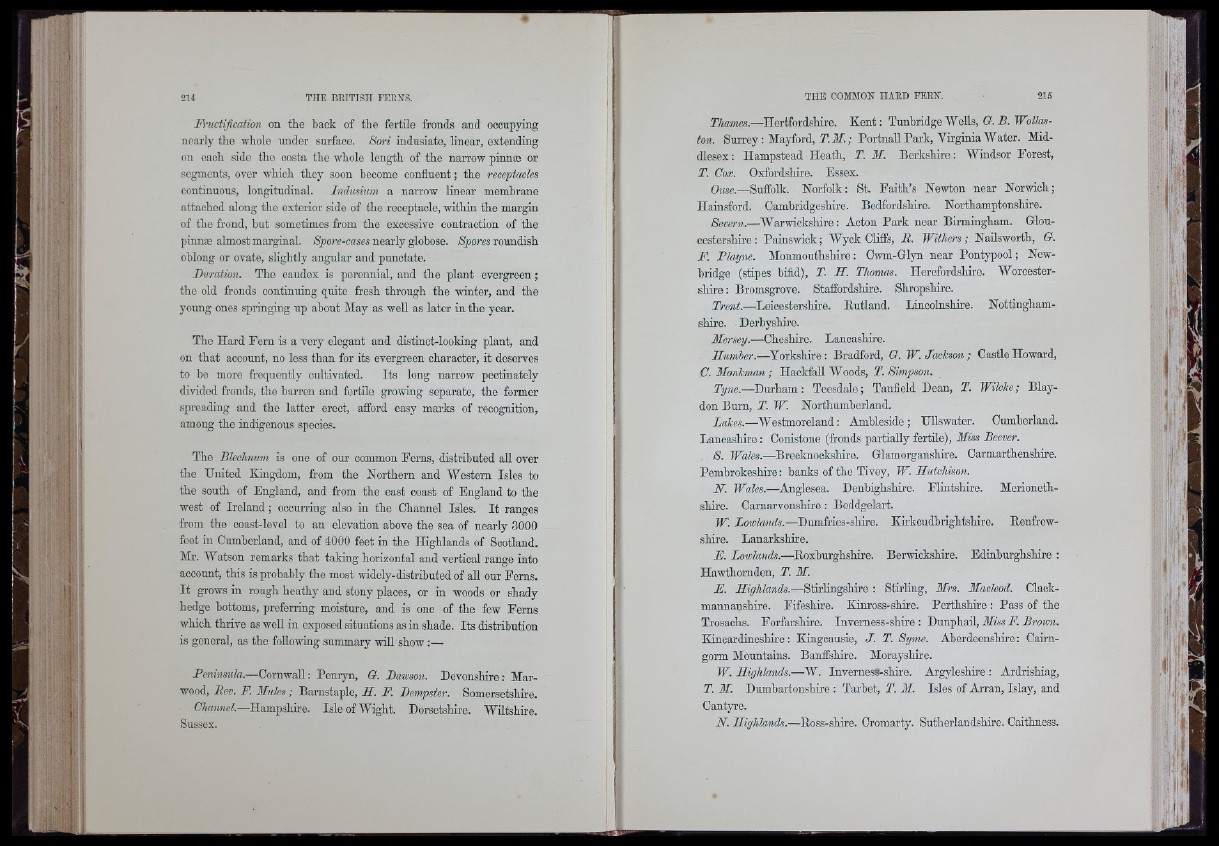
ri
'•■i
|:i!i
Fructification on the back of the fertile fronds and occupying
nearly the whole under surface. Sori indusiate, linear, extending
on each side the oosta the whole length of tho narrow pinnæ or
segments, over which they soon become confluent ; the receptacles
continuous, longitudinal. Indusium a narrow linear membrane
attached along the exterior side of the roceptaclo, within the margin
of tho frond, but sometimes from the excessive contraction of the
pinnæ almost marginal. Spore-cases nearly globose. Spores roundish
oblong or ovate, slightly angular and punctate.
Duration. Tho caudox is perennial, and the plant evergreen ;
the old fronds continuing quite fresh through the winter, and the
j-oung ones springing up about May as well as later in the year.
The Hard Fern is a very elegant and distinot-looking plant, and
on that account, no less than for its evergreen character, it deserves
to bo more frequently cultivated. Its long narrow pectinately
divided fronds, the barren and fertile growing separate, the former
spreading and the latter erect, afford easy marks of recognition,
among the indigenous species.
Tho Blechnum is one of our common Ferns, distributed aU over
the United Kingdom, from the Northern and Western Isles to
the south of England, and from the east coast of England to the
west of Ireland ; occurring also in the Channel Isles. It ranges
from the coast-level to an elevation above the sea of nearly 3000
feet in Cumberland, and of 4000 feet in the Highlands of Scotland.
Mr. Watson remarks that taking horizontal and vertical range into
account, this is probably the most widely-distributed of all our Perns.
It grows in rough heathy and stony places, or in woods or shady
hedge bottoms, preferring moisture, and is one of the few Ferns
which thrive as well in exposed situations as in shade. Its distribution
is general, as the following summary will show :—
Penin.sw7a.—Cornwall : Penryn, Q. Dawson. Devonshire: Marwood,
Rev. F. Mules ; Barnstaple, H. F. Dempster. Somersetshire.
Channel.—Hampshire. Isle of Wight. Dorsetshire. Wiltshire.
Sussex.
Thames.—Hertfordshire. Kent: Tunbridge Wells, D. P. TFbKas-
ton. Surrey: Mayford, Y.Jtr.; PortnaU Park, Virginia Water. Middlesex
: Hampstead Heath, T. M. Berkshire: Windsor Forest,
T. Cox. Oxfordshire. Essex.
Ouse.—Suffolk. Norfolk: St. Faith’s Newton near Norwich;
Hainsford. Cambridgeshire. Bedfordshire. Northamptonshire.
Severn.—Warwickshire: Acton Park near Birmingham. Gloucestershire:
Painswick; Wyck Cliffs, R. Withers; Nailsworth, O.
F. Playne. Monmouthshire: Cwm-Glyn near Pontypool; Newbridge
(stipes bifid), T. H. Thomas. Herefordshire. Worcestershire
: Bromsgrove. Staffordshire. Shropshire.
Trent.—Leicestershire. Eutland. Lincolnshire. Nottinghamshire.
Derbyshire.
Mersey.—Cheshire. Lancashire.
JIumher.—Yorkshire: Bradford, G. W. Jackson; Castle Howard,
C. Monkman; Haokfall Woods, T. Simpson.
Tyne.—Durham : Teesdale; Tanfiold Doan, T. Wilcke; Blay-
don Burn, T. W. Northumberland.
lakes.—Westmoreland : Ambleside ; UUswater. Cumberland.
Lancashire: Conistone (fronds partially fertile). Miss Beever.
8. Wales.—Brecknockshire. Glamorganshire. Carmarthenshire.
Pembrokeshire: banks of the Tivey, W. Hutchison.
N. Wales.—Anglesea. Denbighshire. FUntshire. Merionethshire.
Carnarvonshire : Boddgelart.
W. lowlands.—Dumfries-shire. Kirkcudbrightshire. Renfrewshire.
Lanarkshire.
E. lowlands.—Eoxburghshire. Berwickshire. Edinburghshire :
Hawthornden, T. M.
E. Highlands.—Stirlingshire : Stirling, Mrs. Macleod. Clackmannanshire.
Fifeshire. Kinross-shire. Perthshire : Pass of the
Trosaohs. Forfarshire. Inverness-shire : Dunphail, Miss F. Brown.
Kincardineshire: Kingoausie, J. T. Syme. Aberdeenshire: Cairngorm
Mountains. Banffshire. Morayshire.
W. Highlands.—^W. InvernesS-shire. Argyleshire : Ardrishiag,
T. M. Dumbartonshire ; Tarbet, T. M. Isles of Arran, Islay, and
Cantyre.
N. Highlands.—Eoss-shire. Cromarty. Sutherlandshire. Caithness.
j i
ii !* l
/ I
. i-i
-i ;1
•1
' r i
(..
i
ri ÙÏM
i f f r;. , ' ■